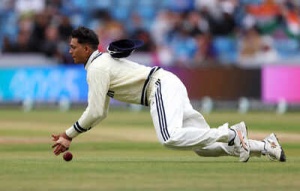BIRMINGHAM: The unusual dimensions of the boundaries at Edgbaston became a talking point on Day One of the second Test match between India and England. Seasoned observers noted the distinctly asymmetrical boundary cushions, a departure from the norm for Test matches at this venue.

England captain Ben Stokes reacts during the second Test. (AP Photo)
The boundary fence on the scoreboard side, particularly wide at long-off for a right-handed batter from the pavilion end, raised eyebrows. Speculation arose, with some humorously suggesting the unused playing area could accommodate a children's game.
The longest boundary measured 65 metres at cow corner, while the straight boundaries were approximately 60 metres. This has led to questions of whether the altered boundaries were intentional to favor England's aggressive batting strategy, especially against India's spin attack.
India's pre-announced strategy to field two spinners in the match adds further intrigue to the boundary debate. This strategic decision raises questions about whether the boundary adjustments were made to encourage England's batters to adopt a more aggressive approach against the Indian spinners.
One of England's perceived weaknesses has been their vulnerability against spin bowling. The Indian team has publicly stated that spin could be a key factor in containing the English batting lineup.
For this Test, India strategically chose Washington Sundar over Kuldeep Yadav, citing Sundar's ability to maintain tight lines for extended periods and his superior batting skills lower down the order.
However, the shorter boundaries are expected to embolden the home side's batters, encouraging them to take on India's spinners with greater confidence.
Memories of the 2019 World Cup resurfaced, where the Indian team expressed dissatisfaction with an unusually short boundary during their match against England at the same venue. On that occasion, the English batters successfully neutralized India's in-form spinners, Kuldeep Yadav and Chahal.
According to ICC regulations, boundary sizes can range from 59m to 90m. Reports indicate that some sections of the boundary were shortened by approximately 5-10m. Furthermore, the regulation stipulates a minimum distance of nine feet between the ropes and advertising boards, but observations suggest one side exceeded this, measuring 20-25 feet.
Newer articles
Older articles
 Gavaskar Calls for Kuldeep Yadav Inclusion in Second Test Amid Bumrah Fitness Concerns
Gavaskar Calls for Kuldeep Yadav Inclusion in Second Test Amid Bumrah Fitness Concerns
 Stokes Lauds England's Opening Duo After Stunning Headingley Chase Against India
Stokes Lauds England's Opening Duo After Stunning Headingley Chase Against India
 Nitish Rana Set for Delhi Return After Disappointing Uttar Pradesh Stint
Nitish Rana Set for Delhi Return After Disappointing Uttar Pradesh Stint
 Former India Selector Blasts Fielding Blunders After Test Defeat: "Simple Catches Cost Us"
Former India Selector Blasts Fielding Blunders After Test Defeat: "Simple Catches Cost Us"
 Rishabh Pant Redefining Cricket: Greg Chappell Hails Wicketkeeper-Batter as a "Match-Winner"
Rishabh Pant Redefining Cricket: Greg Chappell Hails Wicketkeeper-Batter as a "Match-Winner"
 Steve Smith Eyes Grenada Test Return After Finger Injury
Steve Smith Eyes Grenada Test Return After Finger Injury
 Blackcaps Gear Up for Blockbuster Home Summer Against Cricket Giants
Blackcaps Gear Up for Blockbuster Home Summer Against Cricket Giants
 Mirabai Chanu: Olympic Medalist Reveals Relentless Focus on Training, Weight Even During Family Time
Mirabai Chanu: Olympic Medalist Reveals Relentless Focus on Training, Weight Even During Family Time
 Nitish Rana Eyes Delhi Return After Disappointing Uttar Pradesh Stint
Nitish Rana Eyes Delhi Return After Disappointing Uttar Pradesh Stint
 Rishabh Pant Achieves Career-Best ICC Test Ranking; Bumrah Retains Top Bowling Spot
Rishabh Pant Achieves Career-Best ICC Test Ranking; Bumrah Retains Top Bowling Spot